#7 Peter Daszak was the perfect Brit for the American job
Meet the biodefense salesman of the decade
Same disclaimer from part 6: this is obviously a Wuhan lab leak hypothetical based on an accident, not an accusation. This is a series of posts not so much to discuss ‘lab’ leak but ‘what’ leaked.
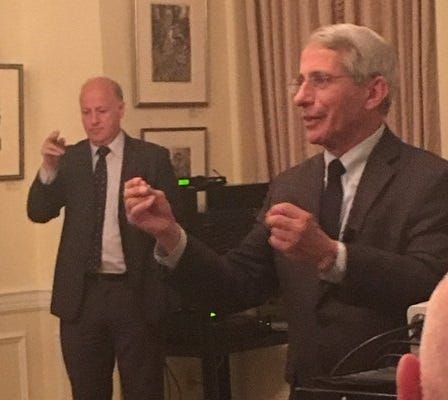
On New Year’s Eve of 2020, Dr Peter Daszak was at his two-acre estate in a suburb of New York City, still jet lagged from a Singapore bat conference. Daszak opened his EcoHealth email to find an urgent message from a collaborator, Dr Ralph Baric of the University of North Carolina: “have you heard any news on this?”
Baric sent a ProMed alert; “maybe as many as 27 cases with 7 severe in wuhan--ards like pneumonia.” Both scientists found this late 2019 news odd because two months earlier, they had a “NIAID SARS-CoV call” with the Wuhan Institute of Virology.
We do not know the context of the Oct 2019 call. Linfa and Baric were footnotes in the $120,000 WIV R01 grant but major figures in the $14M DARPA Defuse proposal (try not to conflate the two projects, but they dovetailed nicely).
Daszak quickly replied to Baric on New Year’s Eve. His EcoHealth colleague Hongying Li was “working on it right now to find out more information. She found a new report from a Wuhan Government website that came out today and I'll forward that to you in a minute.” Daszak then posted the ProMed alert on his Twitter account and replied to Baric: “Hongying is hearing from good sources that they have found a candidate virus in some samples, and results will be sent out soon.” Daszak copied both Dr Linfa Wang and Dr Danielle Anderson of Duke University.
The two people on Daszak’s mind, after being notified of a mysterious flu in Wuhan, were Linfa and Dani. These were the same two Duke University professors who were crawling around the BSL4 in late 2019. These were the same two US University employees who lost the DARPA Defuse project but partnered with Daszak and Baric to bid on NIAID’s CRIED.
Why were these two on Daszak’s mind? Because their biological homework had accidentally leaked from the BSL4. The ‘candidate virus’ was finally sequenced and published on Jan 10, 2020. This caused Dani’s boss, Linfa, to resign as Duke’s Emerging Infectious Disease director.
Daszak & Baric
Daszak replied to his NIAID Program Officer that SARS2 was close to Rp3. This was an irrelevant 15-year-old bat sample used for testing antibodies in Chinese farmers living near bat caves in Southern China, located 1,000 miles from Dani’s BSL4.
EcoHealth’s Jan 11th analysis was based on the RdRp, but they curiously omitted 4991 (a.k.a. RaTG13), which was in the public domain.
On Jan 12th, Daszak notified NIAID that Baric was “working to reconstruct and rescue the virus in (his UNC) lab from the SARS2 sequence, so he could do further work on it.” Baric “leads one of the few labs in the world that can re-create coronaviruses just from their sequences. Bureaucratic hurdles would make it difficult for China to ship the actual virus quickly to other countries.” Baric was asked if he needed NIH or CDC permission to resurrect the virus, but he said no (46:00).
Baric reported his SARS2 findings to Daszak on Monday: “Looks like we found our highly variable SARS-like CoV!” The ‘highly variable’ line was the exact same language Baric used in their DARPA Defuse bid, submitted just two years earlier.

The ‘highly variable’ phrase was used in Baric’s bat vaccine paper, published three years earlier.
The ‘highly variable’ line described Baric’s reverse genetic system, which he himself used to create SARS-CoV-2.
Baric did not use the No See’m method to cover up a lab leak. It was used to hide the engineering scars in a “virus vaccine,” beautifully tailored for a Chinese bat’s immune system.
At the same time Baric downloaded the SARS2 genome (with RRAR furin cleavage site), he uploaded a 2019 coronavirus paper (with RxxR cleavage motif). It described a novel coronavirus with “exogenous trypsin” and “cathepsin L,” just like he proposed in Defuse, just like the virus was circulating in Wuhan. Mammalian bat cells also have furin, trypsin, and cathepsin, just like you and me.

Baric eventually reconstructed SARS2 for 2020 publication, but he covered his tracks with unnecessary modifications to the genome.
Baric and Daszak had nothing to fear as long as the nearest sample to SARS2 remained this irrelevant Rp3 bat sequence (or ZXC21 and ZC45). Their collaboration with the WIV did not have a published sequence even 90% close to what was currently circulating in Wuhan. Remember, if a virus was engineered, wherever it spilled over into the human population does not tell us where it was engineered.

Linda Saif of Ohio State University (above) was not listed in the R01 grant, but she helped Baric cover up an engineered origin. He responded, “Thank you for your efforts.” Baric later published a SADS paper, also listed in Defuse. SADS was a bat coronavirus that infected Chinese and American pigs since “pork & poultry biosecurity was of concern to both US and China national security.”
When the bat shit hit the fan
On Jan 9, 2020, Daszak echoed Linfa’s white lie that SARS2 came “from bats.” Daszak said the novel coronavirus was “approximately 80% similar to SARS1,” and this “supports the hypothesis we put forward in our new NIAID grant with Baric, Linfa, Dani, and Shi; SARS-like coronaviruses that are more than 10% divergent in the Receptor Binding Domain are a high risk for emergence.”
Just six months earlier, in the summer of 2019, Daszak and Baric’s “hypothesis” was submitted for NIAID’s CREID project. They were seeking viruses less than 25% different from SARS1. The circulating SARS2 was 22% different from SARS1, so mission accomplished, because they found what they had created!

The proposed start date for CREID was March 1, 2020, but Dr Shi Zhengli’s name never appeared in the revised (06/17/20) CREID documents. It only listed Dani, Linfa, Daszak, Baric, and Fauci’s Rocky Mountain Lab (RML).
On Jan 15th, Linfa visited Shi’s lab in Wuhan and said they discussed RaTG13. Shi wanted a closer match than 96% to prove SARS2 was a bat virus. He also joked that Shi “can publish more freely than I can outside of China.”
Linfa defended Shi against lab leak rumors because “they didn’t have that novel coronavirus in the laboratory.” This was a half-truth since ‘that novel coronavirus’ was in Dani’s BSL4. Linfa returned home to his Singapore basement and wouldn’t hug his own daughter for the next two months because he knew SARS2 was a contagious bat vaccine that he helped create.
On Jan 23rd, Shi was invited to a WHO teleconference. She replied to the extensive list of bio-bureaucrats, including Daszak, Linfa, Baric, and Vincent Munster of RML. She was “happy to participate in the discussion.”
That next day on Jan 24th, Shi uploaded her nearest known genome to SARS2, called RaTG13. This was two weeks after Linfa had resigned and the SARS2 genome was published. This was two weeks after Baric and Daszak misled NIAID. And all of this was 18 months after they proposed to test a “consensus sequence” like SARS2 in Wuhan.
In a Jan 24th interview, Baric briefly mentioned Shi’s RaTG13 preprint (45:30), before logging into the same WHO conference. The RaTG13 sample was collected by Shi in 2013, but it has been Baric’s unicorn since 2015. RaTG13 was 4% different from SARS2, just as he proposed to create in DARPA Defuse.
After Shi’s publication of RaTG13, the rumors of engineering were spreading faster than Covid. Daszak, Linfa and Baric were now worried about “our collaboration,” so they decided to push, but not sign a Lancet article condemning the lab origin conspiracy theory. They wanted “some distance from us,” so Baric said this was “a good decision.”
One week later, Daszak disclosed RaTG13 came from the Mojiang mine in southern China, but only after Shi published it on Jan 24th, kickstarting the US led coverup. Curiously, EcoHealth did not include RaTG13 in their 2020 Nature paper.
On Jan 27th, Daszak reminded Fauci of their collaboration with the WIV.
On Jan 28th, Fauci downplayed asymptomatic transmission.
As Major Joseph Murphy later explained in his DARPA Defuse letter, “the asymptomatic nature (of SARS2) was explained by the bat vaccine-intention of its creators since a good vaccine does not generate symptoms.”
Baric had patented a method to “improve or otherwise modulate an immune response in a subject without deleterious effect on the subject.” He studied mammalian cell “immune evasion” for a long time. And immune evasion was a design feature, not a bug, in Munster’s self-spreading bat vaccine project called DARPA Preempt. Murphy reminded us, “As is known, Dr Fauci with NIAID did not reject the DARPA Defuse proposal” to vaccinate bats in Wuhan.
The same day as the infamous Feb 1st teleconference, Fauci personally approved his colleague, Daniel Chertow, to read a prepared NIAID statement at a Washington D.C. press conference.
On Feb 3rd, Fauci organized a National Academy of Science meeting with Daszak and Baric. They invited the FBI and White House but framed Kristian Andersen’s engineering concerns as a conspiracy theory. Lab leak rumors were building around Baric and Daszak, but Daszak emailed Baric one month later to say the NAS meeting helped clear their names.
On Feb 9th, Daszak appeared with Fauci on a Newt Gingrich podcast. Daszak repeated Fauci’s favorite line: nature is the worst bioterrorist. Since Newt was a famous politician, Fauci wanted their conversation uploaded to NIAID’s webpage.
Newt later soured on Fauci and the recording was never uploaded. During sworn testimony, Fauci “did not recall” any conversations with Daszak, but when Fauci was shown the above email, the body language changed.
Newt had asked both Fauci and Daszak about the “biological warfare center” in Wuhan, but neither disclosed their subcontractor, Dani, was inside the BSL4 lab.
Dani’s BSL4
On Jan 5th, Daszak noted the WIV BSL4 was “up and running. We’re collaborating with people who’ve already trained and worked in it.” In April, the Washington Post reported safety issues at the WIV, but Daszak said the BSL4 was “set up with US advisors” and ‘passed international inspection.’ But Daszak freaked out when the mobile phone report was published.
The report included both Dani and Linfa’s mobile phones at the BSL4 in late 2019. NIAID asked Daszak to “disclose and explain out-of-ordinary restrictions on laboratory facilities, as suggested, for example, by diminished cell-phone traffic in October 2019, and the evidence that there may have been roadblocks surrounding the (BSL4) facility from October 14-19.” Daszak never responded, so the “pencil dust” R01 grant was canceled (but don’t confuse with $82M CREID grant).
The R01 was recently renewed with Linfa but without Dani, Shi, or WIV. Fauci claimed EcoHealth would “sue us and win in a microsecond.”
Daszak’s above rant was correct because the public record “bat-CoV work” in the news at the time “was NOT EVEN IN the BSL-4 lab.” But Linfa and Munster always used a BSL4 for their live bat challenge studies, and Daszak’s Defuse proposal nominated Dani to test American-made bat vaccines on Chinese bats in the WIV.
By April 2020, the bodies were piling up in New York City, so the guilty group started to console each other. Baric attenuated the bat vaccine for the bat’s tank-like mammalian immune system, so SARS2 was a killer fresh out of the (BSL4) box. Baric’s UNC-employed wife, Toni, told Daszak that “we are kindred souls in this mess.”
Baric rambled about Remdesivir on CNN, and Daszak replied, “Welcome to the Resistance.”
Daszak wanted everyone to use Baric’s Gmail to avoid future FOIAs, since UNC was a public US university. Private institutions like Duke University and EcoHealth are not subject to US FOIA laws.
Daszak also invited Fauci’s aerosol specialist, Vincent Munster, to sign the Lancet letter, but he never signed. An EcoHealth board member, Rita Colwell, asked Daszak for a SARS2 transmission specialist, so he quickly introduced Munster.
There was genuine curiosity if SARS2 was airborne at the beginning of the outbreak because lab mice were not a transmission model. But Munster was vague if SARS2 was airborne, even though all five transmission models are found in his BSL4 lab.
Fauci downplayed the report that Covid could travel up to 27 feet (MIT later revised it up to 60 feet). Three years later, Fauci finally admitted Covid was as contagious as measles.
On April 17th, Fauci made reference to the infamous Proximal Origins paper he helped draft and distribute.
Just two days later, Daszak and Fauci thanked each other for the coverup.
In Nov 2020, Daszak was appointed chair of the Lancet Origins task force by Jeffrey Sachs. “I liked the fact that he was quite involved in China, knew a lot about natural spillovers, and was the guy doing this. So I thought, Gee, it would be great if he would lead the task force,” Sachs said.
Allegedly, Daszak’s first words to the commission were ‘no bats in the lab.’ Daszak was excited when Dani was appointed to the commission. “As a virologist who has worked in high-biosecurity containment labs worldwide, I look forward to bringing my experience and expertise to bear in the search for answers.” But whichever lab Dani worked at; live bats were always present.
In May 2021, Daszak mentioned live bats in the Wuhan BSL4 would not be unusual, “just like US labs,” while linking to the WHO report on Covid’s origin.

In June 2021, Sachs grew suspicious of Daszak’s conflict of interest and forced him out as chair. He was replaced by Gerald Keusch of the Boston BSL4. But three months later, Sachs noticed Keusch's name was on the recently released NIAID CREID documents, right next to Dani.
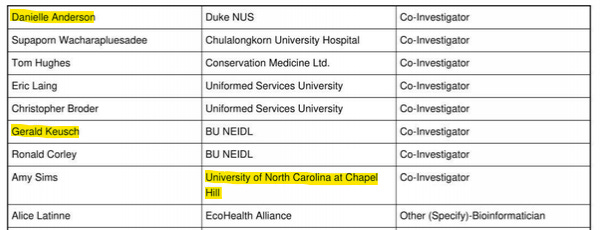
That same week in September 2021, Major Murphy leaked the DARPA Defuse documents, so the commission was disbanded. Dani was quiet during the Lancet meetings, but she had a lot to say after being dismissed: “I have placed Sachs in the same category as Alex Jones — not worth engaging in discussion about.” For the first time, we saw Dani’s name next to a person of interest.
The rejected group of virologists published their own findings. Dani summarized that “our paper recognizes that there are different possible origins, but the evidence towards zoonosis is overwhelming.” Daszak has since joked about an Aussie like Dani in the BSL4.
How did Daszak get here?
Peter Daszak was born in a small coal mining town near Manchester in the 1960’s. His Ukrainian father (pronounced Das-Shack) was taken prisoner by the Allies during World War II, but released into the British community due to post-war “labour shortages.” He raised two sons; one is now an opera singer, but the 8-year-old Peter loved reptiles and dreamed of becoming a zoologist. Peter discovered and named a new species of centipede called Cryptops daszaki. An older Peter reflected, “I’m not a posh Brit, I’m from the working class north…we don’t like to hug and talk about our feelings.”
Their Welsh mother led Peter to a zoology degree in Wales. He was described by a teacher as “really bright,” and a future colleague praised his writing ability: “He has an impeccable understanding of rhetorical strategy, persuasive writing or argument, and consideration of his audience when developing prose.” This British writing skill helped Daszak secure a lot of American biodefense grants.
His first research project was studying a parasite in a lizard’s gallbladder. Peter was fascinated with a “result that no one else had seen,” so he would get a PhD on parasites while living in an East London squat. He named a new parasite called “lsospora daszak” and this unique line of thinking led to his 1990’s claim to fame: amphibian diseases.
He discovered the cause of a mass die-off of frogs from Australia to Panama, unexplained for a decade. Daszak suggested that the fungus responsible was linked to the wildlife trade in bullfrogs, sold as pets or food. This was the first step in a career focused on the interaction between humans, nature and viruses.
Then President Bill Clinton and Vice President Al Gore commented on his fungus-killing frog discovery. Daszak graphically told the NYT in 1998: “It's one thing to go and look for frogs and say they're gone, but what we needed were the bodies to work on, at last we seem to be getting somewhere.” Dr Daszak later noted “parasites” are a unique species that “need to be conserved” in a 2004 NPR interview.
Old friends described him as “the funny northerner” with a ‘wry Mancunian humour’ and it showed on stage. In 2011, the pudgy Daszak entertained a TED crowd with three giant hissing cockroaches hiding in his zookeeper outfit.
He moved with his wife from London to Atlanta in 1998. He volunteered at the US CDC lab in Atlanta while waiting on a USA work visa. His first project was in a BSL2, studying what turned out to be Nipah samples from southeast Asia. This project led to a career change from studying amphibians to flying mammals. His first major paper suspected bats as the reservoir host for Nipah.
The US CDC eventually agreed and was the first to build a live Egyptian Fruit bat colony, which Linfa envied.
After the CDC, Daszak worked as a parasitologist at the University of Georgia for two years. He was often quoted in newspapers as a public health expert during novel disease outbreaks. He called it “pathogen pollution” and blamed “globalization,” while often using the royal we, as in ‘we need to take this issue seriously.’
The doomsday headlines of his quoted articles got worse after 9/11. Daszak was quoted in the NYT almost every year from 2010 to 2019. The astute, biodefense salesman moved his message from newspapers to Netflix as the medium evolved, but the mission remained the same.
Origins of EcoHealth
Gerald Durrell (1925-95) was a British naturalist who wrote a popular children's book. It was written as an autobiography with embellished details but was considered the Harry Potter of its day. The book sales funded his travels, while he collected exotic animals and sold them to local zoos. He eventually set up his own zoo on an island in the English Channel. His international travel was partially funded by a 1971 conservation trust set up in America.
Durrell’s Wildlife Trust was called the Consortium of Conservation Medicine. It was a US academic think-tank without any laboratories but with a lot of academic connections. This non-governmental organization was an asset, since it would quickly hire for the project driven biodefense world. A former employee said “there were no equal opportunity presentations to sit through, or videos on laboratory environmental health and occupational safety to click through.”
They hired Daszak in 2001, who started work on his first 2002 NIAID grant for Nipah. Daszak was researching the origin of those Nipah samples, that he previously studied in that Atlanta lab. The master marketer then invited an American TV program, 60 Minutes, to the remote Malaysian islands. He declared your American tax dollars are spent well on my watch!
Daszak was clad in head-to-toe khaki on a boat speeding towards the remote Malaysian island of Pulau Tioman. He was a “virus hunter” off to search for bats suspected of harboring the Nipah virus. “Almost 75% of the emerging diseases in humans actually come from wildlife...or domestic animals,” he warned. “We are looking for the next HIV, the next SARS.” This nascent area of scientific study, now known as conservation medicine, shaped the next two decades of Daszak’s career.
Daszak’s growing international rolodex proved valuable to the bio-bureaucrats in Washington D.C. A former DARPA official described EcoHealth as a “ragtag group and a middle guy, a backseat collaborator willing to get on an Air China jet, eat terrible food, and stay in bad hotels.” The job description was best described in NIAID’s grant to EcoHealth:
Building on preliminary data that demonstrates bats are a key wildlife reservoir, and that emergence is due to a range of anthropogenic drivers, this team will 1) develop predictive models of global `hotspots' for the future emergence of bat viruses; 2) use a large repository of bat biological samples to conduct targeted surveillance in these `hotspots' for known and undiscovered bat pathogens, elucidating the unknown diversity of the bat ‘virome’ and; 3) using a range of in vitro techniques (including infection in bat cell culture), examine the pathogenesis of these new viruses, and a pool of available bat viruses which have not yet emerged in humans. This multidisciplinary approach represents the first, concerted effort to understand the depth and breadth of the process of emergence within a key group of wildlife hosts associated with the recent emergence of SARS, Nipah, Hendra, Ebola and Marburg viruses.
Daszak goes to China but bat samples are sent to America
Ian Lipkin of Columbia University was featured prominently in Daszak’s first 2002 NIAID grant. He was instrumental in helping Daszak gain access to China. Daszak was adjunct faculty at Columbia, and Lipkin was the “Science Director of (NIAID’s) Northeast Biodefense Center.”
George Gao of China’s CDC ignored Daszak on New Year’s Eve, but he invited Lipkin into China during the 2020 pandemic, who knew by Dec 15, 2019.
In 2004, Daszak teamed up with Shi and Linfa, looking for viruses in Chinese bats. Linfa suspected bats as the SARS1 origin, since he helped trace the Hendra horse virus and Nipah pig outbreak to local Asian bats.
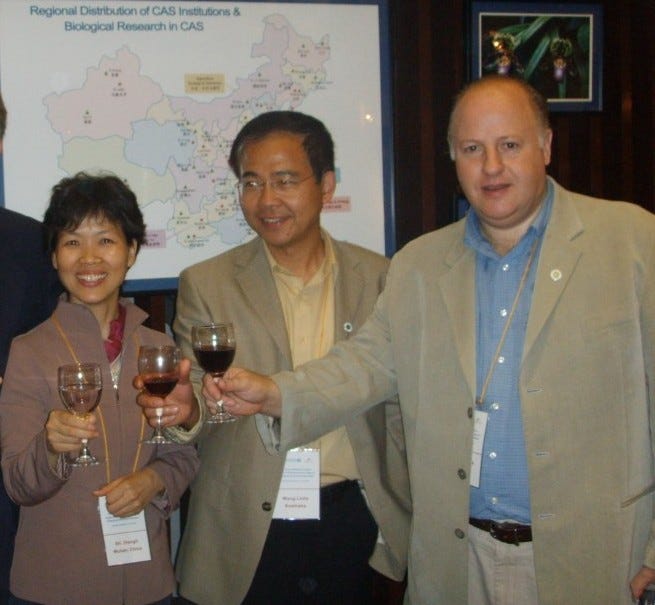
They were all part of the ‘field team’ (3:49:00) digging around Chinese bat caves looking for Nipah. Daszak said they “failed, but we did find SARS” in local Chinese bats.
In the same 2020 TWIV interview, Daszak mentioned “that there is a lot of talk of (live) bats in (the WIV) lab…but the Chinese horseshoe bats are really hard to keep in captivity.” He also had a slip of the tongue while discussing the connection between 4991 and RaTG13, calling it a “consensus sequence.” This was actually Baric’s description of the genome in the 2018 Defuse proposal. And both Linfa and Dani referenced Baric’s “consensus” sequence in 2019.
In 2005, Daszak, Shi and Linfa published their groundbreaking paper showing SARS1 came from Chinese horseshoe bats. This discovery led to Daszak’s first coronavirus collaboration with NIAID in 2008. The Wuhan Institute of Virology was first mentioned in the 2010 progress report, testing nearly 400 Chinese bat samples. After years of US funded research, they narrowed the list of Chinese bats to just one species: Rhinolophus sinicus (which Baric later proposed to vaccinate in DARPA Defuse).
American virologists liked Daszak’s access to Chinese pathogens, so he was well funded by NIAID, State Department and the Pentagon. In 2013, Baric of UNC wrote a cover letter for Daszak’s grant application. This R01 grant helped fund Shi’s adventures into those Chinese bat caves.

“All of our research results are published in English journals,” Shi said in 2020. “Virus sequences are saved in the [US-run] GenBank database too. It's completely transparent. We have nothing to hide.” In 2021, Shi told the NYT “my” lab was not involved in gain of function, and “I” did nothing wrong, so “I” have nothing to fear.
In 2013, Baric traveled to the WIV to meet Shi, who shared an unpublished SHC014 bat sample. Shi couldn’t isolate the virus in her lab, so she just emailed the genetic sequence to Baric, who ‘resurrected’ the dead sequence into a live virus. This procedure was called a Material Transfer Agreement (Baric’s MTA) and started a two-way street of collaboration between Wuhan and Chapel Hill (counterfactual thread).
The collection of Baric’s SHC014 bat sample was funded by an obscure State Department program called USAID Predict. A year later, Shi traveled to the Mojiang mine, using NIAID’s R01 funding, to collect RaTG13. Shi sequenced and uploaded the genome (4991 renamed to RaTG13 in 2018) to NIAID’s Genbank server in 2016 and 2018. Was a SARS1 bat vaccine a solution to this potential SARS2 problem?

Origins of One Health and USAID Predict
The current head honchos of EcoHealth follow in Durrell’s footsteps. They use conservation as a funding source for their global travels, selling exotic animal samples to US academia. They are basically globetrotting vets, with business class expense accounts, on the taxpayers dime.

These four (nonprofit) EcoHealth officers collectively paid themselves $1.1 million in 2018. Most of the $18M in 2018 revenue was from one program: USAID Predict. The profit margins are incredible when subcontracting grant work to cheap Chinese labor. As an example, the “pencil dust” R01 grant was worth $600,000 per year over five years, but EcoHealth only paid out $120,000 to the WIV. Why? In the DARPA Defuse proposal, we learned the WIV rate was as low as $7/hour, but the bid was worth $14M to EcoHealth, Duke, and UNC. The Chinese airfare, per diem, and lodging for bat sampling were pennies out of millions of dollars worth of biodefense grants.
Daszak hired Jon Epstein from Colombia as adjunct faculty in 2003 so he “would not have to pay for subscription fees to scientific publishers.” Jon followed in Daszak’s steps and first appeared in a 2006 NYT article blaming men, not bats. Daszak also hired Kevin Olival in 2011, but only after Daszak asked NIAID to approve Kevin’s CV. NPR followed Kevin to Asia in 2017, so they logically asked him about the SARS2 in 2020.
Daszak’s longtime colleague, Billy Karesh, had a similar childhood. He grew up in South Carolina, raising orphaned birds, squirrels, and raccoons. He released them when they were old enough to take care of themselves. Karesh worked as a zookeeper and settled in at the Bronx Zoo in 1989. Ten years later, Dr Karesh became the Director of the Field Veterinary Program. The Bronx Zoo was owned by the 100-year-old Wildlife Conservation Society.
'What I do for a living is not fun, at least not while I'm doing it.'' Believe him. He figures that only 5% of his travel time is spent working on animals directly; the remainder is spent dealing with the enigmatic rules and customs of third world bureaucracies. Animals do not make the work dangerous, he says; what does is having to travel ''through the middle of rebel-infested nowhere and mediating my fate with teen-age soldiers equipped with better weapons than educations.'' But his love for the job emanates from every page. He confesses that he's addicted to the adrenaline rush.
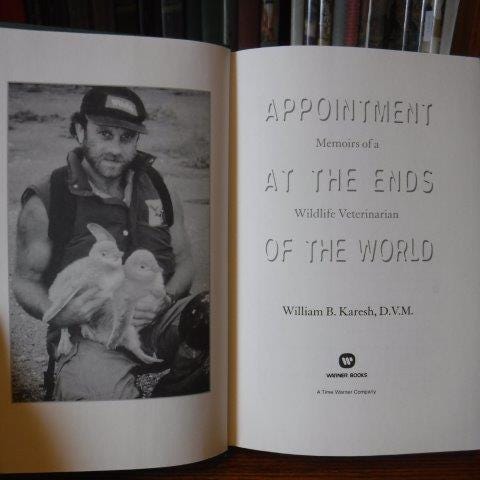
Karesh was a wildlife veterinarian traveling the globe 10 months out of the year. It was apparently a shoestring budget but funded by the non-profit Wildlife Conservation Society (do not confuse it with Daszak’s Wildlife Trust with Karesh’s WCS, but it’s a future partner to USAID Predict).
Dr. Karesh described once trying to get a research grant for surveillance of animal diseases that infect humans, known as zoonoses. The National Institutes of Health told him to apply to the Department of Agriculture, he said, and officials there sent him to the Fish and Wildlife Service, which told him it had no mandate to study disease.
“Then we went to Homeland Security, and they understood what we were talking about,” Dr. Karesh said. “But they said: 'You're an orphan. No one does this.' And in their rankings, we're lower than people trying to blow up the subway in New York.”
After spending years in a zoo and out in the bush, Karesh thought human health, livestock health, and animal health were an “artificial division created by people.” He officially coined the term “One Health” in 2003 during an Ebola outbreak in Africa. He told a reporter that “human or livestock or wildlife health can't be discussed in isolation anymore; there is just one health. And the solutions require everyone working together on all the different levels.”
In 2005, Karesh wrote a Foreign Affairs article about this One Health concept. Diseases “shared a worrisome key characteristic: the ability to cross the Darwinian divide between animals and people.” He noted “the world’s not flat, it’s a mixing bowl.” Therefore a “broader, more democratic approach is needed, one based on the understanding that there is only one world -- and only one health.”
The following year, Karesh and his WCS colleagues launched a series of global conferences with the theme “One World—One Health.” What started out as the WCS avian influenza network eventually morphed into the $213M USAID program, which now included Daszak’s Wildlife Trust.
By 2009, Daszak was coordinating a “very well funded project between five universities, which kind of took over” the Wildlife Trust. At the same time, Daszak took over as President of the trust and some of those universities would become members of USAID Predict.
Months later, Daszak rebranded the 30-year-old Wildlife Trust as EcoHealth Alliance and hired Karesh as his loyal #2 lieutenant. Karesh’s capabilities in the field and connections with the local press helped build EcoHealth. They wanted a “dual focus on local wildlife conservation and its ongoing leadership in the area of conservation medicine, and the relationships between animal ecosystems and human health.” The latter of the two was much more lucrative. Karesh called it a $1B ‘investment’ by the US government, and he now lives in a very nice New York City apartment!
Everyone remembers 9/11, but everyone forgets Amerithrax. A US government scientist mailed airborne anthrax to political targets and (successfully) increased biodefense funding. One of the many ‘weaponized’ letters was addressed to Tom Daschle’s Senate office. In 2017, Daschle headlined an EcoHealth event at the Cosmos club in Washington D.C. He told the D.C. crowd that “biodefense is an issue important to me because my office was a target of the anthrax attacks 16 years ago.” Daschle now heads the Blue Ribbon Biodefense commission with Liebermann and Karesh.
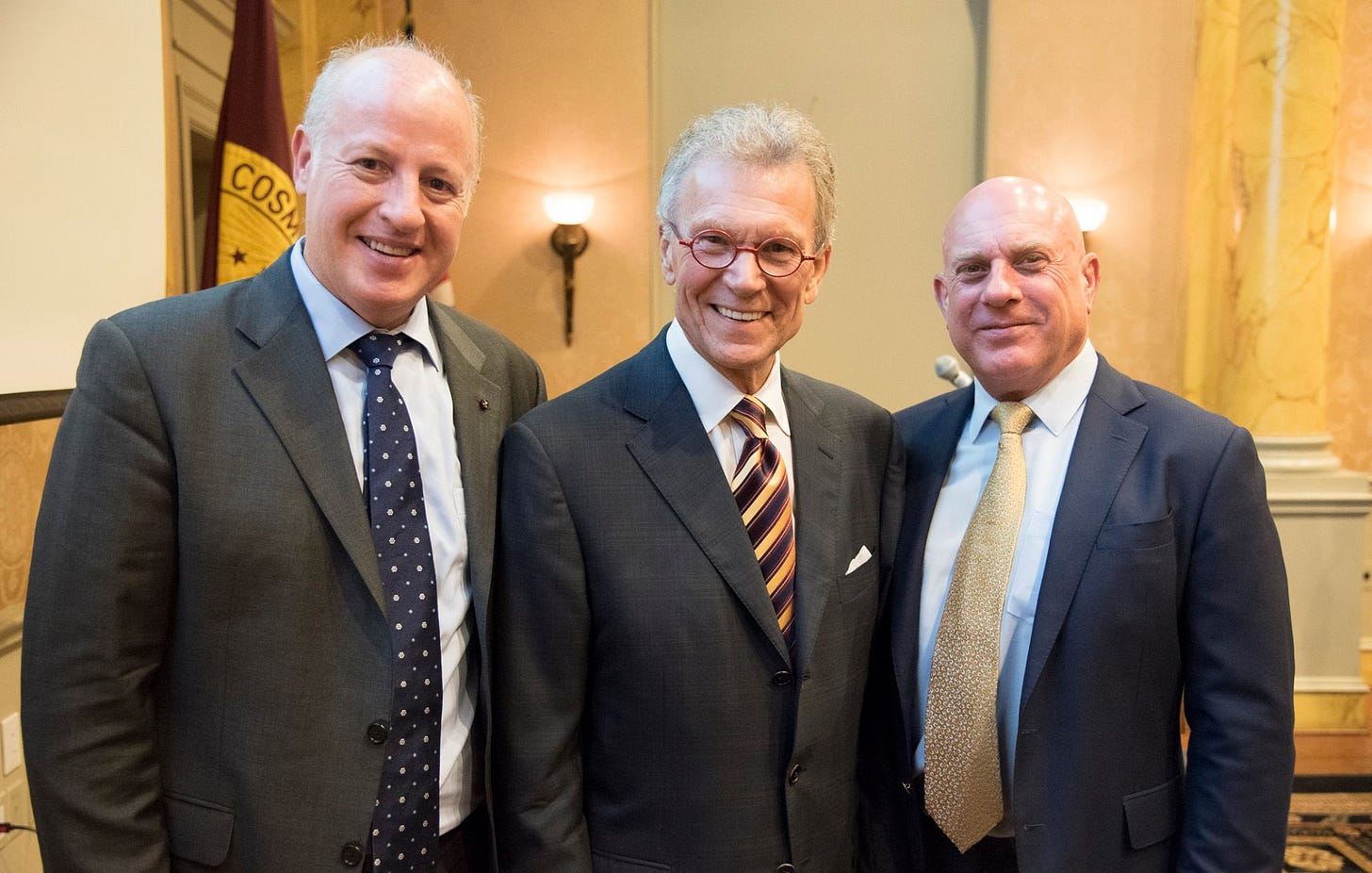
The “military-academic complex of scientists” began after 9/11. Fauci’s NIAID secured most of the biodefense money, which had a “corrupting” effect. As an example, Daszak, Linfa, Dani, and the founder of Predict all quoted Donald Rumsfeld’s “known unknown” Iraq War line. Rumsfeld was referring to terrorism, but Daszak was referring to the problem that USAID Predict helped create: too many virus samples.
In 2008, Daszak brought up “bioterror” agents in his NIAID grant. Daschle recently asked Daszak if we're crying wolf too often? Daszak responded: "I would say we've not cried wolf with Ebola, SARS, and influenza; rather, I would say that we've dodged bullets.”

Project Bioshield was all about biodefense vaccines. Since polio only infects humans, it was easily eradicated with vaccines. But zoonotic pathogens like Ebola, SARS, and MERS can ‘jump species’ and hide in a ‘reservoir host’ that harbors the disease without illness. It was USAID Predict, along with modern sequencing technology, that helped virologists narrow down that huge list of mammalian suspects to bats.
USAID Predict
Daszak’s 2019 CREID CV brags to Fauci’s NIAD that “I have also led large contracts from USAID (institutional lead on $75 million PREDICT-1 and $138 million PREDICT-2.” The USAID Predict program was sponsored by the State Department. It used US universities (e.g. Linfa’s alma mater UC Davis) as a friendly face in foreign countries. It also used American newspapers to scare the wallet out of the taxpayers’s pockets.
Daszak now blamed human “encroachment” into wildlife lands, but the reality was the exact opposite since the world is greener than ever.
USAID wanted to “detect, prevent, and respond to future biological threats.” The idea was to collect virus samples from around the developing world and ship them back to US labs for creating ‘countermeasures.’ This term may sound nefarious, but the Predict program was run by dorks, not spooks. It was a bunch of do-gooders with good intentions but bad outcomes.
Dr Andrew Huff, the former EcoHealth employee, recalled, “While reading about the EcoHealth organization, I fell in love with the mission.” He called the Predict program “sexy” and wanted to work in the big money modeling department. It included 50 remote EcoHealth coders, creating fancy Bayesian models for dull academic reports.
USAID Predict was a classic foreign policy boondoggle that gave local tax dollars away to foreign entities. But the money came with strings attached since they shared samples with American virologists. USAID Predict funded nearly every significant bat sample ever collected, so below is a list of projects:

The three dead Mojiang miners in April 2012, where RaTG13 (96% similar SARS2) was collected in 2013, hence the name.
The WIV1 bat sample was later ‘shipped’ to UNC and RML for infection experiments in Egyptian fruit bats. This 2018 project was the beginning of DARPA Defuse in Montana.
The SHC014 sample in 2011, which Shi emailed Baric so he could ‘recover the virus’ using his exclusive reverse genetic system. This led to their controversial 2015 paper that kept Fauci up until 3 AM in early 2020.
The Rp3 sample was collected in 2004. It was the 3rd sample taken from a Rhinolophus pearsonii bat and 92% similar to SARS1. It was used in the coverup email by Baric and Daszak in early 2020.
The RshSTT182 sample was collected in 2010 from Cambodia, and 93% similar to SARS2. In short sections, the Cambodian sample was closer to SARS2 than RaTG13 (think Baric’s consensus sequence).
The RacCS203 sample was 94% similar to SARS2. It was collected by USAID Predict in Thailand and was most similar to China’s RmYN02 at the S1/ S2 boundary. The Thai sample was from Linfa’s paper and edited by Dani, who both referenced Baric’s “consensus virus” in 2019.
As a Washington Post reporter summarized about USAID Predict:
It pays for the transportation back to various laboratories. Some of these samples, over the years, have been brought back to institutions here in the United States where they are analyzed, to a great extent, by US-based researchers.
Dawn Zimmerman of the Smithsonian Museum worked on the USAID Predict program in Kenya. The video below shows you where all these bat samples ultimately wind up: Washington, D.C.
EcoHealth sent their Chinese bat samples to Ian Lipkin’s lab at Columbia. Lipkin’s lab forwarded the coronavirus samples to Baric’s Chapel Hill lab, which just downloaded the sequence and used reverse genetics to create a live Chinese virus in North Carolina. “And you (Baric) had developed a reverse-genetics technique that allowed you to synthesize those viruses from the genetic sequence alone? Yes”
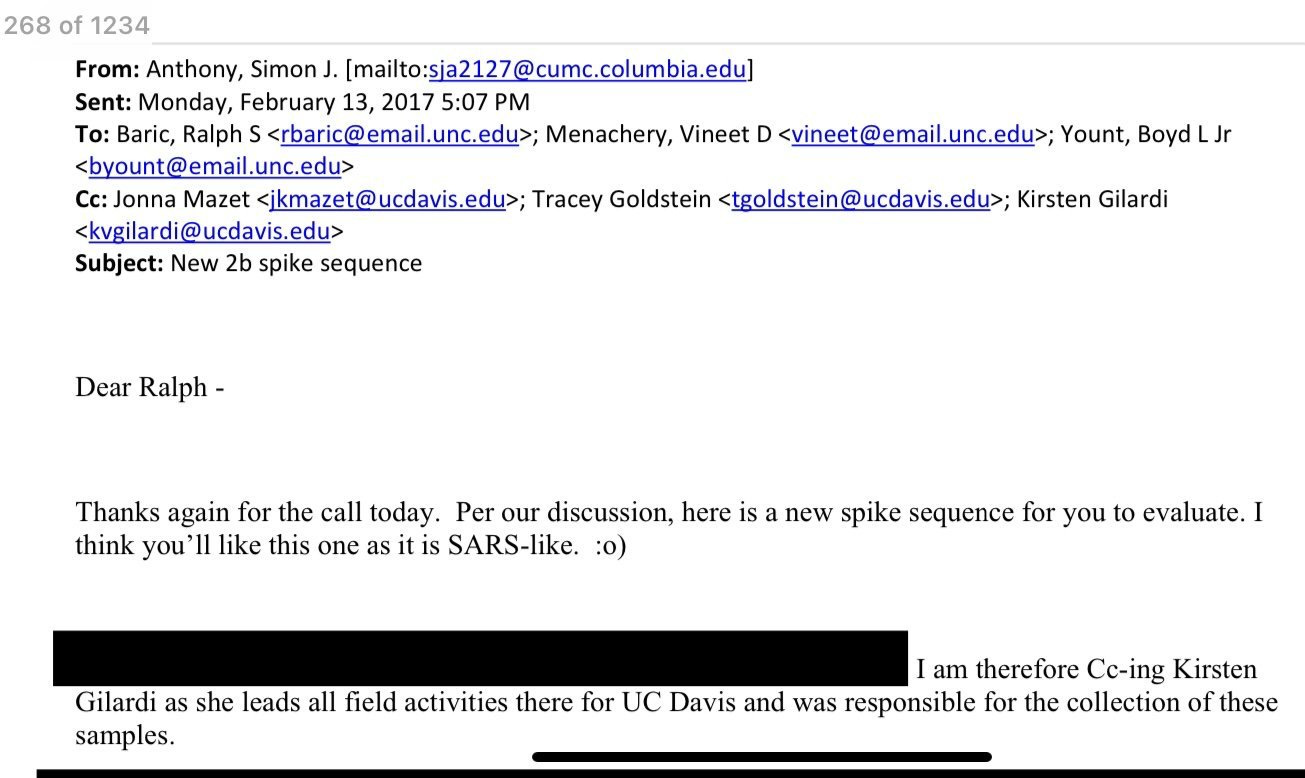
The Predict program was a Hoover vacuum in every bat cave, sucking up every bat sample, trying to ‘predict’ or “forecast” the next zoonotic spillover event. The program was best described by Kevin, a longtime employee of EcoHealth. “I've spent the last 10 years working with governments under (PREDICT with NIAID and DTRA funding) building the trust needed to share viral sequence and other bio-surveillance data, so understand the importance and challenges of making this happen and getting it right.”
The former EcoHealth employee, Andrew Huff, grew disillusioned over time, noting that “every virus discovered was an easy peer-reviewed publication and another bullet point for their CVs.” The entire program was pseudoscience, but “who wouldn’t enjoy a swanky scientific job traveling the planet, acting as a diplomat, and making deals?”
A Washington Post reporter described virus hunting as a ‘chain or risk’ with the potential for ‘catching your experiment’ via needlestick, bat bite, mishandling samples, etc. In 2012, a 25-year-old American researcher became sick and was hospitalized for two weeks after sampling Egyptian fruit bats in Uganda.
Why DTRA?
The second largest source of EcoHealth’s government money, behind USAID Predict, was the Pentagon’s Defense Threat Reduction Agency. In 2013, Daszak booked the Cosmos Club for the head of DTRA: Andy Weber.
Weber had previously invited a junior senator from Illinois, named Barack Obama, to a Soviet-era bioweapon lab in Ukraine. Senator Obama recalled from his 2005 Kyiv trip, “I saw test tubes filled with anthrax and the plague lying virtually unlocked and unguarded — dangers we were told could only be secured with America’s help.” In 2009, President Obama declared the H1N1 flu an emergency and supported the creation of the USAID Predict program.
An Obama official, Victoria Nuland, was caught on a famous Kiev phone call in 2014, and recently admitted to US supported Ukrainian biolabs in Odessa.
DTRA was searching for “dual use” pathogens around the globe, or what was classified as “special agents” and therefore weaponizable. During a One Health presentation, someone asked Karesh why DTRA was funding his Rift Valley Fever research? “When you think about diseases and armed forces, actually, if they’re sick, it’s more of a problem than if they die, so it takes several people to take care of a sick person. Wounded and sick soldiers are a bigger hardship on armed forces than just dead soldiers…but that is not why we are studying it.”
Rift Valley fever was another popular topic at the Cosmos Club! But it turns out DTRA was more interested in poking pigs and buying Toyota Land Cruisers than researching foreign pathogens. Huff, the former employee, described the program as “hardly nefarious.”
In Jan 2019, Karesh emailed Baric about a potential DTRA project, but “it is not a huge amount of money” since it was less than $500,000. DTRA’s mission was to protect the ‘warfighter,’ but there are no American soldiers in China. In the 2018 DARPA Defuse draft, Baric highlighted “about 90,000 of the 550,000 deployed US military (warfighters) are in Southeast Asia, mostly Japan and South Korea.”
The secretive agency was a dead end of grant money, since Andy Weber was against gain of function funding. He later criticized Fauci and NIAID’s risky research.
Munster wrote a 2015 cover letter for the “strongest support” of the EcoHealth project on Western Asia bat research. DTRA shipped bat samples from Georgia (the country) to the US CDC (in Atlanta, Georgia), where Daszak started his American career. By 2015, the BSL4 in Atlanta was becoming the Egyptian fruit bat research capital of the world.
Unlike Germany, both the US CDC and Fauci’s RML are obviously sitting on unpublished EFB bat transmission research using SARS2.
EcoHealth was not a Trojan Horse for the CIA; it was a middleman for foreign bats and the pathogens they carry. Fellow virologists aren’t covering up for China or EcoHealth; they just have “similar interests.” The Baric and Munster of the biodefense world can focus on lab-based bat research, while EcoHealth contractors can climb into foreign bat caves and ship samples back to home base.
Early in the outbreak, National Geographic (with DARPA scientists) hosted a TV special on ‘virus hunters.’ They blamed bats for the source of nasty pathogens like Ebola and SARS2. They followed a white man into a dark African bat cave as his team collected live bats using a harp trap. But the TV host didn’t tell us they were EcoHealth employees (and why they visited an Iowa deer lab?)
The Washington Post quoted Daszak during the pandemic:
For years, the raison d’etre for EcoHealth’s research in China and elsewhere has been “bio-surveillance.” The aim, Daszak said, is “to find out which of the viruses in the wild even possibly could infect people so we know where they are and we can stop them from emerging.”
“It’s a little bit like if you listen to phone calls from Afghanistan. To find the terrorists, you have to listen to all the phone calls,” Daszak said. “Only when you’ve heard the phone call do you then go in and find out who these people are and disrupt those networks.”
The entire purpose of Shi, USAID Predict, DTRA and NIAID was to give Baric an advance copy of the potential foreign pathogens that might emerge naturally (or unnaturally), so he could create countermeasures (Remdesivir, human vaccines, bat vaccines, etc.)
SARS2 was always about live bats
Karesh sat next to Fauci’s lieutenant, Daniel Chertow, during the Feb 2020 press conference. It was here in Washington, D.C., that Karesh started the Wuhan bat soup rumors by showing a bat video from a quirky Indonesian island, not the modern metropolis of Wuhan. The powerful Senator Joe Liebermann even gave the opening statement.
The bat soup conspiracy was a SARS1 origins story from the Era of Wild Flavor (Yewei in Mandarin) and was considered a way of gaining “face,” prosperity, and good luck in southern China. No one eats tiny Chinese horseshoe bats for meat, which themselves are picky eaters. Karesh gave a more nuanced lab leak answer two years later.
In 2003, Fauci entertained the crazy idea that SARS1 was a potential bioweapon. So ten years later, in 2013, he hosted a coronavirus meeting with Daszak, Baric and Munster. They discussed how to infect American bats with foreign pathogens. Daszak repeated his favorite line that bats don’t have passports, so they can collect bat samples from friendly Middle Eastern countries and neighboring hostile countries (e.g., Armenia, which borders Iran).
Around that same time, interest in bat viruses increased and virologists started the bat genome project in 2017. EcoHealth ran their fancy Bayesian models, based on a decade of USAID Predict sampling. They published a Nature paper claiming bats harbor the most viruses and spread the word on CNN, WSJ, CNBC, and NPR. A year later bats were big news! By 2019, with decreasing cost of next generation sequencing technology and increased bat cave sampling, virologists rightly or wrongly (even comically) blamed all these global events on bats.
Daszak had an ongoing debate with Linfa. “Are bats a special viral reservoir?” Daszak claimed no, but “Linfa was right all along.”
Is there something special about bats? The question has been hotly debated among researchers studying the origins of deadly viruses. Marburg, Ebola, severe acute respiratory syndrome: They have all been linked to bats, leading some scientists to argue that something about the mysterious mammals makes them especially likely to harbor viruses dangerous to humans. "Bats are special," is their motto. But others argue that the bat order is very well-studied and very big—one in five mammalian species is a bat—biasing results (1,300 of the 6,500 mammalian species are bats).
That debate may finally be over. A broad look at all viruses known to infect mammals suggests that bats are, indeed, more likely to carry unknown pathogens that can wreak havoc on humans. Surprisingly, the study comes from researchers who until now were bat doubters. "As a scientist, you accept the results of your own study—even if they prove you wrong!" said Daszak.
DARPA and EcoHealth
In 2017, EcoHealth tweeted a Harvard Business Review article. “Neither the U.S. nor the world is ready for a global pandemic. A number of near-misses, from Ebola to Zika, should have all of us more concerned. One way to mitigate the risk of this looming threat is with a DARPA-style initiative that would bring policymakers, businesspeople, and scientists together — but at an international level. After all, pandemics do not recognize national borders.”
The article was written by former Pennsylvania governor, US senator, and Homeland Security director Tom Ridge. He then invited Daszak to testify at a Blue Ribbon biodefense panel. Ridge asked Daszak to “ignore the dollar amount that might be involved for preemptive action in the hotspots like Africa and Southeast Asia. What kind of preemptive actions are most appropriate?” Daszak answered ‘we are collecting samples in China, leading us to rural bat caves, which are a SARS hotspot.’
Daszak and Baric studied those Chinese bat caves for the past decade, using Shi’s R01 grants. In 2018, Baric referenced the Mojiang mineshaft in his live attenuated bat vaccine paper. Was a bat vaccine a solution to the “national security” problem?
Baric had previously called DARPA a “funny organization” by noting that “personal interactions are key.” In 2017, DARPA invited themselves onto the UNC campus, and he told his wife, Toni, that they are a “persistent bunch.” The following year, in early 2018, the DARPA Preempt project was publicly announced, and bids were solicited. DARPA wanted a “proactive approach” to “protect U.S. troops (warfighter) in places where there are endemic and emerging infectious diseases.”
By 2017, despite massive infusions of grant money, EcoHealth faced a brewing financial crisis since 91% of its funding came from the federal government, and 71% of that came from the PREDICT grant. The renewed grant, known as USAID PREDICT II, was slated to end in two years. There was no way to know if the grant would be reauthorized for a third time (it was renewed to Washington State University but quietly cancelled in 2023). The looming possibility that it would expire came to be known internally as the “PREDICT cliff.”
But there was another way that EcoHealth Alliance could ward off the $8 million shortfall it was facing. The Defense Department could serve as a federal life raft in a new ocean of grants. The Defense Advanced Research Projects Agency (DARPA) was seeking proposals for a new program called PREEMPT, which aimed to identify animal pathogens “to preempt their entry into human populations before an outbreak occurs.”
For EcoHealth, the PREEMPT grant seemed like a slam dunk. For years, Daszak had been developing a method of predictive modeling to identify likely sites of viral spillover around the world and stop pandemics at the source. Some questioned the effectiveness of Daszak’s approach. “In 20 years of using this method, [EcoHealth] did not predict a single outbreak, epidemic or pandemic,” Maureen Miller told Vanity Fair. But David Morens, senior adviser to the NIAID director, said that Daszak became one of the “key players” in understanding that “emerging diseases came from animals, the animals had their own geographic ranges, and if you knew where the animals were and what diseases they carried, you could predict hot spots.”
EcoHealth also doubled down on another key selling point: Its unique on-the-ground connections in China would effectively give the U.S. government a foothold in foreign laboratories. As Daszak had told his staff at a meeting some years earlier, one Defense Department subagency wanted “information on what is going on in countries which they cannot access (China, Brazil, Indonesia, India).”
With the PREDICT cliff and the DARPA deadline coming ever closer, Daszak struck an upbeat note with his board members, pointing out that the organization had a strong track record of winning federal grants. “This was the golden ticket,” a former staffer familiar with the DARPA grant application said. “The message was always, ‘We are going to do cool and cutting-edge science. DARPA is the right agency to fund this.’
But DARPA had concerns about the “dual use” UNC technology, so EcoHealth asked for Baric’s definition of a “select agent.” SARS1 was a select agent (bureaucratic term for weaponizable), so they needed a workaround to play with SARS-like viruses in a US select agent lab like UNC.
Baric claimed the “several” Chinese pathogens, which Shi shared with his UNC lab, are bat strains, not human strains, so they are “exempt” from the 2017 gain of function ban. EcoHealth paid Baric an undisclosed sum in January 2018 for his legal consulting and inserted his text into their DARPA bid.
Ironically SARS2 is now classified as a “select agent,” which means only UNC’s select agent lab can work on it.
Inside DARPA, the grant application was met with immediate skepticism. The contract was “never awarded because of the horrific lack of common sense” it reflected, said a former DARPA official who was there at the time.
Likewise, the WIV was also viewed as subpar, especially when compared with the Harbin Veterinary Research Institute, which operated China’s only other high-containment laboratory with the highest biosafety protocol: BSL-4. Harbin was China’s Harvard, said the former DARPA official. The WIV was more like a safety school. EcoHealth had “bolted on” a serious scientist, Ralph Baric, and “podged” the proposal together. Having the nonprofit serve as the prime contractor for a global project with national security risks was like “having your rental car agency trying to run an armada,” said the former DARPA official.
Though two of three DARPA reviewers deemed it “selectable,” the third, a program manager in the Biological Technologies Office, recommended against funding it. He wrote that the application did not adequately mention or assess the gain-of-function risk or the possibility that the proposed work could constitute dual-use research of concern (DURC), the technical term for science that can be repurposed to cause harm or endanger security.
According to Daszak, no one at DARPA expressed any concerns about the proposed research to EcoHealth Alliance. On the contrary, he said, “DARPA told us that ‘we had a strong proposal’ and ‘wished DARPA had greater funding for the PREEMPT program.’
DARPA “couldn’t afford” Daszak’s $14M Defuse proposal, but there was one government agency with deeper pockets than DARPA. This bigger agency was also comfortable funding research in China, which dovetailed very nicely the Defuse proposal:
We will collect data from three caves in that system on: monthly bat abundance and diversity, viral prevalence and diversity, individual bat viral load and host physiological markers; genomic characterization of low- and high-risk SARSr-CoV strains among bat species, sexes, and age classes.”
From NIAID’s R01 in 2019:
We identified one cave system (the "Jinning Cave") in Yunnan Province that harbors Rhinolophus spp. bats with diverse SARSr-CoVs, including some Spike proteins able to use human ACE2 as entry receptors. Bats in this cave carried SARSr-CoVs with all unique genetic elements of the SARS-CoV outbreak virus, suggesting that this site may be a potential public health risk.
From Daszak’s 2019 R01 renewal:
This larger US government agency also had a long track record funding Baric’s “dual use” research. In 2012, Fauci even testified (56:00) that most “dual use research of concern” runs through his labs, like RML in Montana, not the Department of Defense. In a post-9/11 world, Fauci’s NIAID became the new DARPA, a line basically repeated by his own virologist.

Fauci and Daszak
In 2011, Daszak lost weight and traded in the zookeeper outfit for a coat and tie. He gave a professional presentation at the National Academy of Sciences in Washington, D.C. He concluded the NIH spends a “huge amount of money on diseases that don’t kill many people.”
That astute observation would drive Daszak to the top of the biodefense club. A year later, Daszak became an elected member of the exclusive Cosmos Club in Washington D.C., where EcoHealth once hosted Ivanka and Jared Trump in 2012. The One Health concept was eventually co-opted by EcoHealth donor Bill Gates
Gates called the “virus itself…a type of vaccine…that created both B and T cell immunity.” He also funded transmissible vaccine research.
Huff noted the Cosmos events were “D list celebrities/personalities, photographers, writers, and artists, as well as powerful C suite executives, lawyers and politicians.” Gerald Durrell would have approved, since the billionaire donors just wanted their picture taken with the cute foreign animals.
On invitations, EcoHealth described the events as “educational.” Inside the nonprofit, however, officials called them “cultivation events.” The return on investment was excellent: For about $8,000 in Brie and Chardonnay per event, they got to network with prospective federal funders. As the organization’s 2018 strategic plan spelled out, “Given our strength in federal funding, we enhanced our cultivation events at the Cosmos Club in Washington DC, which now regularly attract 75-150 people at high levels in govt agencies, NGOs and the private sector.”
Of all those high-level people, almost no one ranked as high as Fauci, a scientific kingmaker who dispensed billions in grant money each year—and Daszak was determined to share a podium with him. The idea was admittedly a reach. Though he’d met with Fauci and received funding from his agency, Daszak was relatively obscure. But he had cultivated back-channel access to the minders who guarded Fauci’s calendar.
On September 9, 2013, Daszak emailed Fauci’s senior adviser David Morens to see if the sought-after NIAID chief would be available as a panel speaker. Morens emailed back, recommending that Daszak “write Tony directly, thanking him for meeting with you all recently and then inviting him to be a member of this Cosmos Club discussion. That way, it is personal and doesn’t look ‘cooked’ by us.”
Fauci and his advisor, David Morens, later blamed SARS2 emergence on “human behavior,” while Morens and Daszak claimed the earth was too “crowded.”
Though Fauci declined that invitation and several others, Daszak kept trying. In February 2016, Morens passed along a valuable tip: Fauci “normally says no to almost everything like this. Unless ABC, NBC, CBS, and Fox are all there with cameras running. If he were asked to give THE main talk or the only talk that might increase the chances.”
The gambit worked. Fauci signed on to give a presentation on the Zika virus at the Cosmos Club on March 30, and the RSVPs flowed in. The guests came from an array of deep-pocketed federal agencies: the Department of Homeland Security, the U.S. Agency for International Development, the Pentagon, even NASA. As Daszak would declare at a board meeting in 2016, the “Washington, DC cultivation events have been a great way to increase our visibility to federal funders,” according to meeting minutes.
Fauci’s presentation was on Zika and was included in the upcoming $82M CREID project.
Bats (like humans) are highly ‘gregarious’ mammals. Both species live in high-density colonies, with one cave in Texas housing twenty million Mexican free-tailed bats (referenced in DARPA Defuse). This provided an ideal environment for both scientific schmoozing and transmission of pathogens within populations.
The ‘incomparable’ Dr Anthony S. Fauci gave a presentation at the Cosmos Club cocktail event on March 30, 2016. Just two days earlier, Daszak had given an infamous C-SPAN interview detailing how Chinese colleagues manipulate coronaviruses.


Exactly one year later, in 2017, Daszak shared the stage with Fauci at the Washington D.C. conference for infectious diseases. He gave a presentation on predicting the next outbreak in China.
The slide refenced all the Chinese bat samples that EcoHealth had collected with USAID Predict and NIAID funding, now being shipped to labs like RML and UNC.
Daszak was the only non-governmental official on the D.C. stage. He served as a middleman for much-needed pathogens from China. Later in the year, Daszak, Shi, Linfa, and George Gao flew to D.C. for a virus conference with Fauci as keynote speaker.
George discussed host jumps: from flu to Ebola. Shi’s presentation was on the diversity of coronaviruses in Chinese caves. Linfa asked why bats are special? It’s a unique mammal because they can fly. Daszak’s presentation was probably titled: The Beginning of the End of the Pandemic Era. He estimated 1.6 million unknown viruses and told the D.C. audience that we are not prepared for the ‘dual threats’ of natural or unnatural viruses, so let’s fund the Global Virome Project!
The $1B idea was based on the Human Genome Project, but it was recycled into the USAID DEEP VZN project and later canceled.
Daszak then took his usual first-row spot in the audience, while Fauci gave his usual presentation: emerging and re-emerging infectious diseases: from AIDS to Zika. The Brazilian mosquito virus was in the news that year, so Fauci capitalized on the funding opportunities. One of his scare slides allocated NIAID an additional $30M from Congress! Another scare slide was designed to “overwhelm” congressmen for more funding. His NIAID department was now twice the size of DARPA’s, but Fauci was still discussing SARS1 and SADS from China. Fauci told Daszak, “It was good to see you today” after the meetup at the (above) conference.
During the pandemic, Baric published a NIAID-funded SADS paper, which was also listed in Defuse.
Munster also apparently visited EcoHealth’s NYC office often here in 2017.
2018
In Feb 2018, Daszak was up late in his Switzerland hotel working on a rough draft of the DARPA Defuse document. It was recently obtained by USRTK, but the document, not the headline, was the bombshell.
The controversial Daszak edits actually made it into the final Defuse document.
Shi would always conduct binding assays and do some humanized mice work, but if you believe SARS2 infects ‘humanized’ mice, you also believe SARS2 infects raccoon dogs (which it doesn’t). The WIV BSL2-3 comment had more to do with coronaviruses being cheaper to work on versus “Ebola, Marburg, Hendra, Nipah.” But Linfa used a BSL4 for all live bat infection studies.
Linfa “believed treating wild bats…by spraying was superior to other invasive strategies that might be considered by DARPA, including genome editing (CRISPR or RNAi) and vaccination.” But Baric wanted to vaccinate the bats for “long term immunity” and “test in captive bats infected with SARS or select SARS like viruses, like SHC014, which we could provide.” The overall Defuse plan stayed the same, Baric the bat virologist inserts furin cleavage sites into live coronaviruses, then sends to Linfa for testing on live bats, in Wuhan.
Karesh noted it was “hard to vaccinate wild animals because they are running loose,” so EcoHealth proposed a concept developed by USGS. They were trying to vaccinate wild bats against white-nose syndrome, spraying the bats as they left the caves at night. This method was called a transferrable vaccine, as opposed to the more ‘scalable’ but dangerous transmissible vaccine for bats. They lost the DARPA project to Munster’s transmissible bat vaccine concept. And the same program officers managed both DARPA Preempt and USAID Predict program.
In July 2018, Kristian Andersen of the Scripps Institute (not to be confused with Danielle Anderson) openly criticized EcoHealth, who published the “most irresponsible press releases I have ever seen” causing “unnecessary confusion and panic” over an Ebola outbreak. Around the same time, Andersen and his future Proximal Origins co-authors criticized programs like USAID Predict and called for its defunding. Andersen’s Scripps Institute was a private research center that relied heavily on NIH facilities and administrative F&A fees. Scripps F&A is nearly 90%, but EcoHealth was in the 30-40% range. Andersen also privately called Daszak the ‘Grand Wizard of EgoHealth’ and ‘Dastwat.’
In October 2018, the bat crew headed to a Hong Kong conference. It included Daszak, Baric, and Linfa collaborating with the “batlady.”
A week later, in October 2018, they all traveled to Wuhan for a WIV conference with Shi. Was the Defuse project back on someone’s Washington, D.C. budget?
Daszak bragged about their “productive collaboration with Shi and Linfa on our NIAID SARSr-CoV Project - 5,370 bats sampled and released, two papers in Nature, one in Cell, 15 others published and more on the way…” He flew home in business class for $9,000.
Daszak, Linfa, and Shi tested rural Chinese farmers living near bat caves. They had been exposed to SARS related (Rp3) coronavirus. These bat caves were about 1,000 miles southwest of Wuhan, so even if China banned the wildlife trade, potential spillover was possible. Was a Chinese bat vaccine the solution to the spillover problem?




In 2018, Daszak rubbed shoulders with the soon-to-be famous British epidemiologist Neil Furguson, Marion Koopmans and Eddie Holmes. He also visited the BSL4 lab on the Boston University campus. Daszak added the BSL4 NEIDL to his 2019 CREID bid, along with Baric, Linfa, and Dani.
In Nov 2018, Daszak was again sitting where he was often found, in the front row during a Fauci presentation. Fauci wanted a universal influenza vaccine, but discussed “original antigenic sin.” He also noted that “chasing after pandemics is costly and inefficient.” Was a contagious animal vaccine the solution to the pandemic problem?
During that same NASEM conference, Fauci was asked about gain of function. He then debated himself about which projects to fund. He thought the airborne transmission studies were “eloquent,” and those pathogens that already spread via the respiratory route (e.g. SARS) were worth funding “for the benefit of society.”
At the same NASEM conference, Daszak chaired a forum on microbial threats.
He appeared next to Fauci’s longtime HIV lieutenant, Emily Erbelding.
She was the head of Fauci’s global “immune system” called CREID. Just three months later, the NIAID CREID grant was posted. When Daszak sent Fauci the “thank you” note during the pandemic, he cc’d the Emily. She was running the CREID grant and secretly met with Fauci and Baric early in the outbreak.
Later in the NASEM session, an FBI Weapons of Mass Destruction employee got the last remark over Daszak. The “FBI is charged with protecting sensitive research and ensuring its security, as well as with protecting the people who conduct that work and their related institutions.” The FBI issued keycards to the few American virologists allowed in select agent labs, like UNC and the University of Iowa. They were more interested in protecting the GoF research, not stopping it, so the FBI WMD agent reminded us of Fauci’s favorite line: the ultimate bioterrorist is Mother Nature.
In late 2018, Fauci and NIAID were caught resuming the controversial experiments to make an H5N1 virus transmissible in mammals. Those researchers used ferrets, but SARS2 transmits efficiently in its close cousin called American mink, which are not found in China but are found in RML.
T-minus 365 days of travel
We will not find Daszak in a BSL4 spacesuit, like Dani or Munster, but we can follow the globetrotter around the 2019 world.
Daszak started off January with a DTRA bat conference. In February, he jetted off in business class to Malaysia on the way to Beijing. Daszak and Hongying (cc’d on Jan 2020 emails) met with George Gao of China’s CDC. Dani was also in the Beijing CDC BSL3 lab working on live bats.
In March 2019, Fauci’s CREID grant was posted online. April started off with another EcoHealth event at the Cosmos Club, headlined by Robert Kadlec. He was the #2 at the HHS department, which oversees NIH and NIAID. He also helped write the 2018 White House biodefense plan, which listed SARS as the first disease on the first page. Billy Karesh even celebrated the President’s signing of the new biodefense strategy!
Kadlec’s 2019 presentation at the Cosmos noted, “There are two big gaps in our defense against pandemics - prevention and recovery so we can make a great business case that pandemic prevention will give us a great return on investment.” Daszak followed up his own tweet during the pandemic, to note Kadlec was a visionary! Kadlec was technically Fauci’s boss at HHS, who received a 3am coverup email during the worst pandemic in history, but he was obviously oblivious to the coverup. Kadlec’s idea was to send Hanes underwear to every American mailbox for use as a mask.
The rest of Daszak’s April 2019 schedule was spent at the United States Capitol (with Karesh) and Switzerland (with Eddie Holmes). In May, Daszak was skiing in Vancouver and drinking in Oslo. He flew business class for $11,000 to Taiwan (where SARS1 leaked from a BSL4). He also claimed, “viruses know how to exploit our travel routes.”
It was reported that EcoHealth and WIV did reckless experiments with the MERS in May 2019, but Daszak ran everything past NIAID first. Daszak later said, “No one was engineering viruses to release to wipe out the global population.”
In June, a slimmer Daszak gave the closing remarks at NASEM, entertaining the Washington D.C. crowd with a dress-for-success story.
The Feb 3, 2020, NASEM meeting, not the secret Feb 1st teleconference or Proximal Origins, was always their official cover. In 2022, a slimmed-down Baric made his first public appearance for induction as a member of NASEM.
In June 2019, Jon Epstein of EcoHealth hosted a disease conference with Vincent Munster.
These two had been working with NIAID to setup a live bat colony in the USA since 2017.
In June 2019, the USAID Predict was winding down. Fauci told the NYT it was being replaced with his $82M project: CREID. “Yes, it’s like Predict, but it wasn’t the cancellation of Predict that inspired it,” since it “was in the works years before Predict was eliminated, and it was created in response to the 2014 West African Ebola outbreak and the 2016 Zika epidemic.” Bob Garry of Tulane even admitted CREID planning started in 2018, which aligns with a surge of academic interest in SARS-like research (furin cleavage sites, TMPRSS2 & SARS from 2018-19).
In June 2019, Daszak submitted his bid for the upcoming $82M CREID project. Daszak recycled Linfa’s batified mice from DARPA Defuse, and Baric apparently had live bats in his UNC lab.
In the CREID proposal, Baric repeated his common line “that viruses up to 10%, but not 25% different” from SARS1 are potential spillover threats. Daszak also tweeted about “our Flight Risk Tracker (FLIRT) because he recycled it from the lost DARPA Defuse bid. That same day, Dani flew from Beijing to Wuhan and spent the last six months of 2019 alone in that BSL4. The proposed start date for CREID was March 1, 2020.
Daszak flew off in business class to Liberia, with $15,000 billed to the USAID Predict program. In July, he was in London and Scotland, while August was spent in Japan and Norway. In September, he spent $19,000 on business class to Malaysia, for the “quietly” canceled Predict, that came to an end after two budget cycles worth $213M. They celebrated the collection of more than 140,000 animal samples and identified 1,000 new viruses!
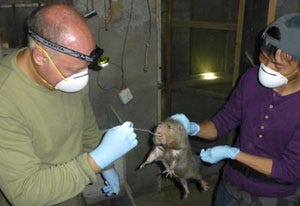
October was even busier for Daszak, since he traveled to Abu Dhabi, then a rat farm that was only 500 miles southwest of Wuhan. And then, like a bat, Daszak flew to Berlin, for a One Health conference in October 2019.
Daszak wanted to auction off a colleague’s fancy bat cuff links and offered one clue: he works on bat viruses in the US? Billy Karesh chimed in the right answer: Dr Vincent Munster!
Around this same October timeline, the Wuhan BSL4 was in a lockdown and Fauci was in Montana. In November, a clueless Daszak reminded his Twitter followers that Baric was on his mind, while defending their risky research. Linfa traveled to the WIV to check on Dani, last seen in the BSL4 on Nov 29, 2019. One week later, Dani and the bat crew would appear in Singapore.
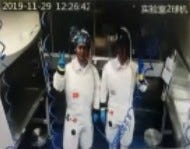
Singapore bat conference
“Unbeknownst to the scientists attending the Nipah conference in Singapore in December 2019, the COVID-19 outbreak had already begun.”

Most scientists involved in the creation and coverup of Covid attended this bat conference. It was the event of the year, organized by Linfa and sponsored by NIAID. The bat conference even included one of Fauci’s co-authors, who later wrote Covid was “more than just the common cold” and mentioned the Wuhan wet market three times. Rocky Mountain Lab was well represented by Vincent Munster and his Dutch wife/co-author, Emmie de Witt.

This was the same conference Daszak gave the infamous interview, but he was still oblivious to what was brewing in Wuhan. He spent the last month of 2019 bragging about how the “spike protein drives coronavirus” spillover events, but we can be “predictive” with Baric’s lab work.
Shi gave a presentation describing an ‘international scientific collaboration’ and offered an open house invite to the BSL4. This was a reference to Fauci’s virologists at UNC and RML, collaborating with Linfa and Dani, all funded by Fauci’s international CREID network.
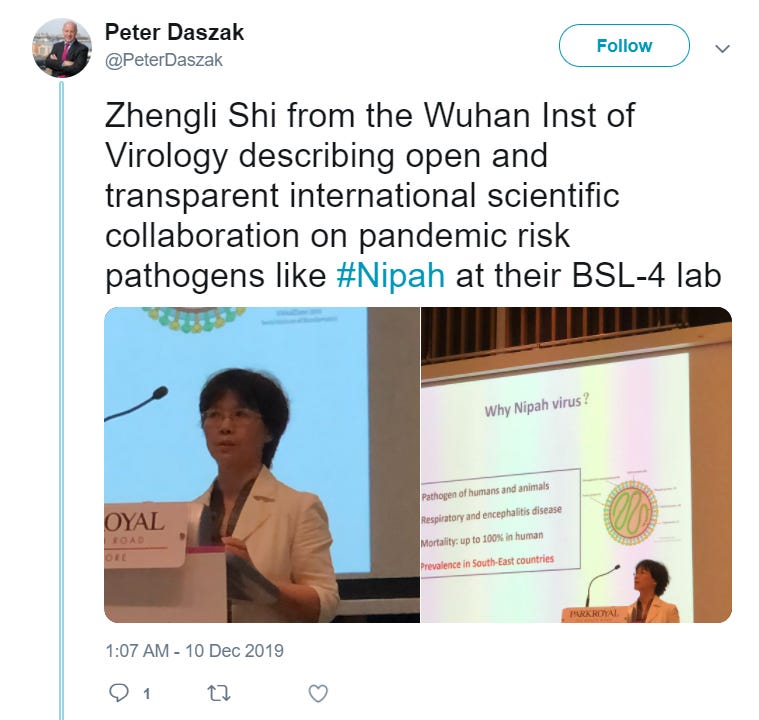
Daszak later deleted the Singapore tweets, but he actually deleted very few tweets, so why were these two posts incriminating? Anyone that studied the Wuhan BSL4 noticed it was built by the West, and “used a lot for cooperation with the West.”

Daszak claimed the WIV did not house live bats—calling it another “conspiracy theory” in a tweet—but later admitted he was misinformed; the lab did have bats at one point for immunological studies, but they were not Chinese horseshoe bats. EcoHealth was required to “catch and release” all wild Chinese bats, but those guidelines did not cover subcontractors like Shi and the WIV.
Live bat research in the Wuhan BSL4
Linfa always asked: why bats? Linfa was envious of the live Egyptian fruit bat colony at the US CDC in Atlanta. Since fruit bats are easy to feed and breed, this particular bat species became the workhorse for American-made bat vaccines at the Rocky Mountain BSL4 lab.
But Linfa detailed the difficulties of feeding tiny Chinese bats in a BSL4. Linfa called it the “puppet show” and why he gave up trying to keep a Chinese horseshoe bat colony alive in a BSL4. In 2005, Linfa had infected Chinese bats with SARS in the Australia BSL4. It was unpublished work, but Dani was at the same lab from 2006-08.

In 2009, Shi’s research team captured a few Chinese horseshoe bats from the wild. The bats were used as laboratory animals, but they needed to be fed every day. During a spring festival, Shi’s students were on holiday, so Shi quietly assumed the task of feeding the bats.
In 2012, Daszak’s colleague captured Chinese horseshoe bats (R affinis), and took blood and anal swab samples that were sent to Ian Lipkin’s lab in New York City. Then the live bats “were released alive from a 3rd-floor Chinese lab window, well most of them, anyway.” All of those Chinese bat samples collected by EcoHealth were either sent to Atlanta, UNC, or RML.
In 2017, both Shi and Dani visited Colorado State University for a bat conference. This bat meeting included Munster, who visited the WIV back in 2015. Munster and Fauci also vaccinated camels against MERS in Colorado, so do not question their resolve to vaccinate bats against SARS in Wuhan.
In 2017, a NIAID representative in Beijing visited Shi in Wuhan and made reference to live bats in the lab, so there is a good reason that the email above was redacted.
In June 2018, the WIV filed patents for a ” worm-eating bat cage.” The WIV also tried to set up a Rhinolophus bat breeding colony “several times, but failed.” Instead, they used “wild-caught captive Rhinolophus” sinicus bats as outlined in DARPA Defuse, probably “captured from Taiyi cave,” located one hour south of Wuhan.
In a draft of the DARPA Defuse proposal, Linfa let us know the bat vaccine plan. Since “we have found that the immune dampening features are (similar) in all bat species,” we could create a bat vaccine using our fruit bat colony in Singapore, then “extend the test to a small group of wild-caught Rhinolophus sinicus bats at the WIV.”
“If we’re proposing experimental work with bats, we should specify that we’ll use SARS-CoV & SADS-CoV host species (Rhinolophus) which can be readily obtained by our Chinese colleagues at WIV,” said Jon Epstein of EcoHealth in a 2018 draft of DARPA Defuse.
In the 2013 Fauci meeting in Washington D.C., Daszak reminded the audience that Rhino bats aren’t on the endangered list (4:21:30). Munster said “working with bats” in a BSL4 was hard, but he was trying to create an Egyptian fruit bat colony. Basically, Daszak and Baric asked Dani and Linfa to do the exact same thing Munster and Fauci did in 2018: grab some “wild-caught” bats, put them in your Wuhan BSL4 lab, and let’s run some bat vaccination experiments!
Linfa only needed 48 hours to receive a bat vaccine from America. The only reason Wuhan was the epicenter of the SARS2 outbreak? Because Shi had the only BSL4 that could keep these picky-eating Chinese bats alive in captivity for a bat vaccine trial.
At the beginning of the 2020 outbreak, Kevin Olival of EcoHealth said, “There was a real concern that not only North American, but wildlife populations all over the world could be exposed.” The USGS wanted to infect New World bats with this Old World SARS2 virus. The live bat research was shutdown but later published. They found SARS2 infects the exact same species of American bat, that was referenced in DARPA Defuse. The New World bat experiment didn’t spread bat-to-bat (like us humans), so the USGS blamed “social distancing” (like us humans).
Flashback to Dani in the Wuhan BSL4:
The initial (bat vaccine) concept had worked well in the New World ‘bats’ (EFB) in the New World labs (RML). Now was another in vivo experiment for the Old World bats (R Affinis) in this Old World lab (WIV).
In 2021, Dani was asked about a ‘secret’ bat colony in the BSL4 but said there are many labs working with bat colonies in multiple countries. “To my knowledge, that was a video made several years ago to promote the lab. There are scientific meetings dedicated specifically to bat virus research and the last such meeting that I attended was in Colorado, USA.”
NIAID recently awarded RML a $125M bat lab and CSU a $12M live bat research facility. They will try and do the impossible: raise Chinese bats on US soil so they don’t have to test an American-made bat vaccine on Chinese soil!
Daszak, at the same time, said, “We didn't ask (the WIV) if they had bats. I wouldn't be surprised if, like many other virology labs, they were trying to set up a bat colony. I know it's happening in labs here and in other countries.”
They were speaking in a half-truth since Daszak or Dani did not deny the live Wuhan bat colony. And Dani never disclosed her role in DARPA Defuse to test vaccines on “wild-caught captive” Chinese horseshoe bats. She was misled about working on Ebola because in late 2019, she was playing with Baric and Munster’s bat vaccine.
Closing remarks of 2019
Daszak’s former NIAID Program Officer in China, Dr. Eun-Chung Park, was also in attendance at the Singapore bat conference.
Dr. Park had worked with EcoHealth and Munster to try and setup an American bat lab in 2017. She gave a presentation on “The Progress and Challenges in Vaccine Development” and ended it with a question for the Singapore audience:
Should a bat vaccine be considered to control Nipah transmission? Bats constitute the reservoir, not only of Nipah but also other viruses causing disease in humans. Preventing viral shedding from bats could prevent human disease.
Fauci’s NIAID planted the seed in Singapore about vaccinating the animal reservoir: bats. Ironically, the US CDC wouldn’t allow importation of Chinese bats, so Fauci said, “You gotta go where the action is.” This was both the beginning, and the end, of a terrible idea to test a bat vaccine on live bats in Wuhan, that was already spreading in humans at this Singapore conference.

After a few Singapore Slings, Daszak flew home to celebrate the new year in New York City, but the cover-up moved faster than the self-spreading vaccine. Daszak’s high-flying career was temporarily grounded in 2020. He visited Wuhan as a WHO investigator in early 2021, looking for the origins of Covid, but the rest of us have slowly caught up to what happened.
A lie can travel halfway around the world while the truth is putting on its shoes, which was falsely attributed to Mark Twain.












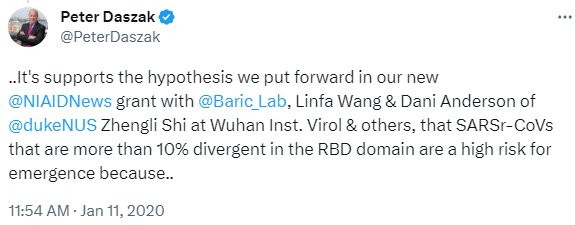























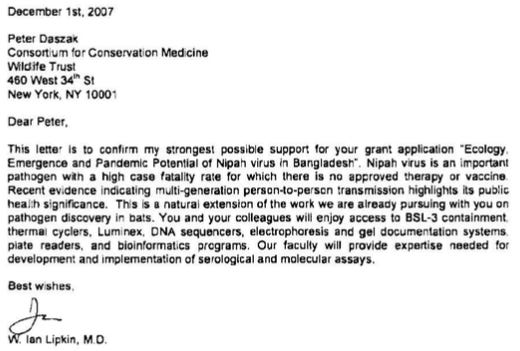



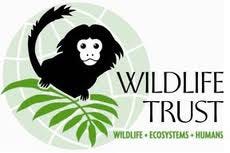









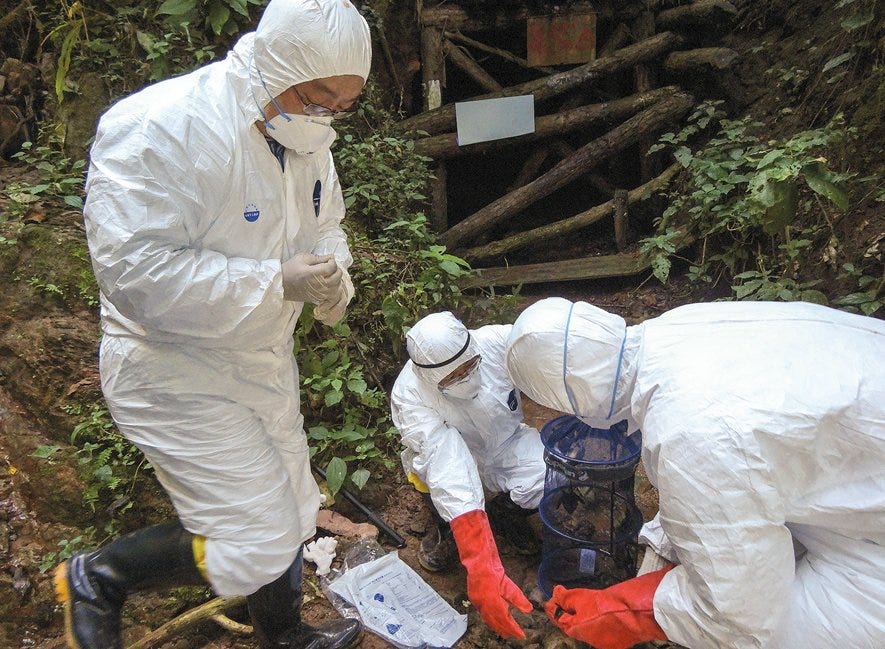
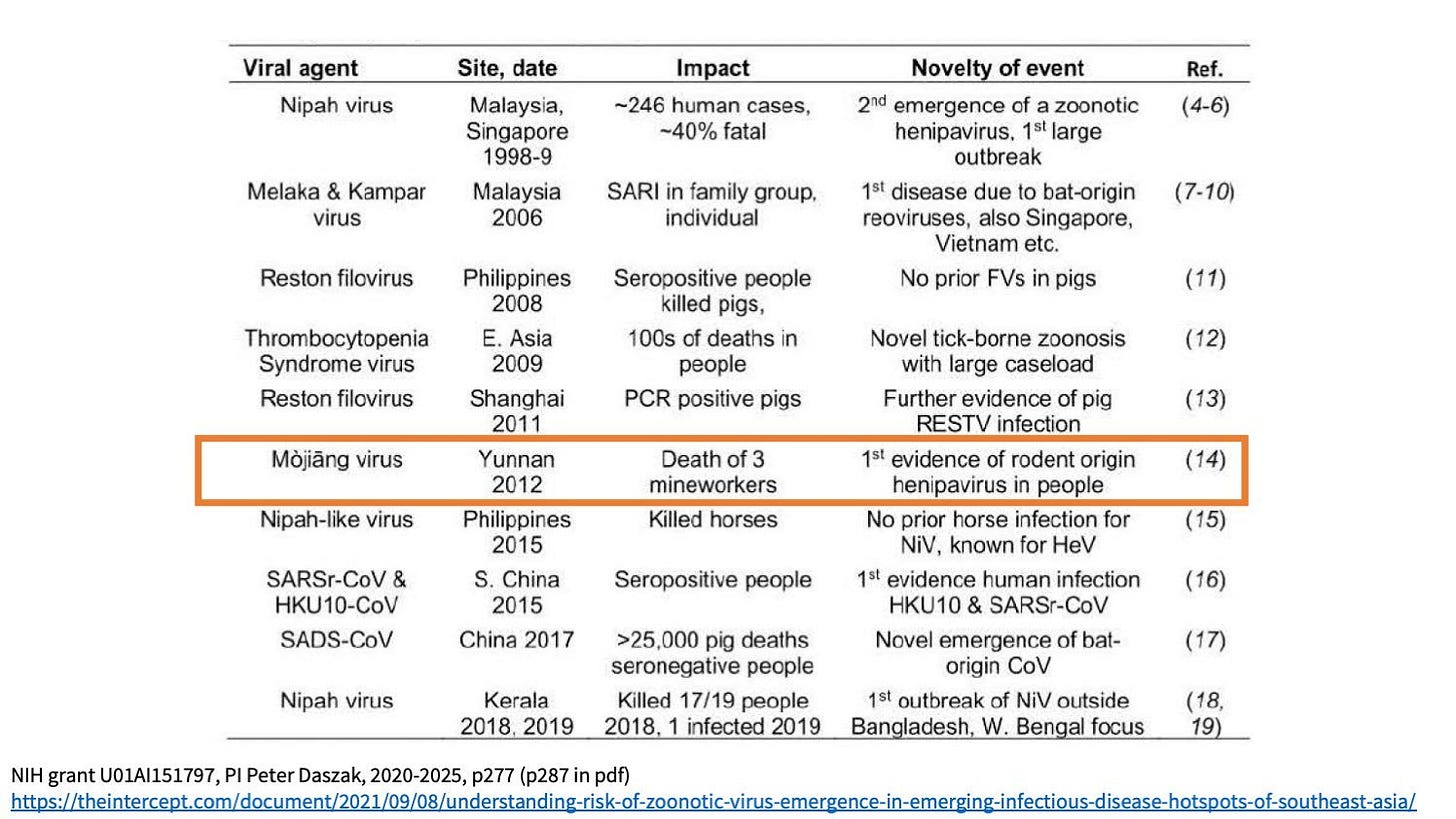



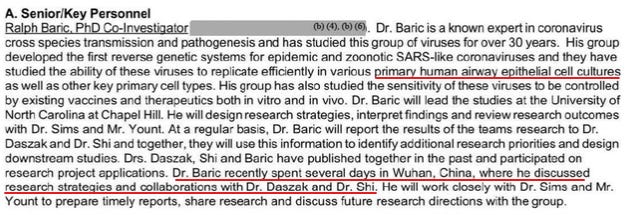












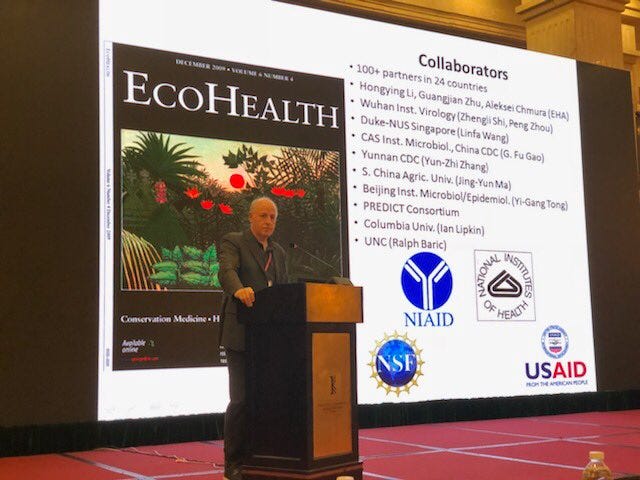
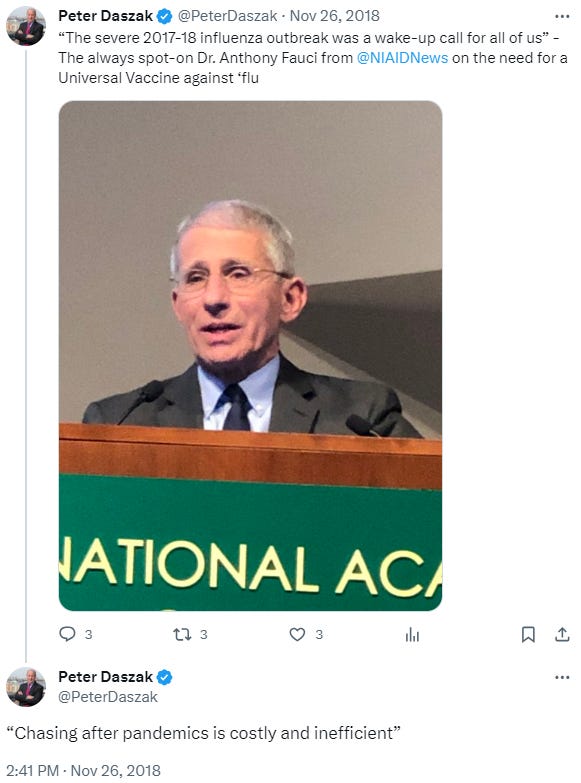






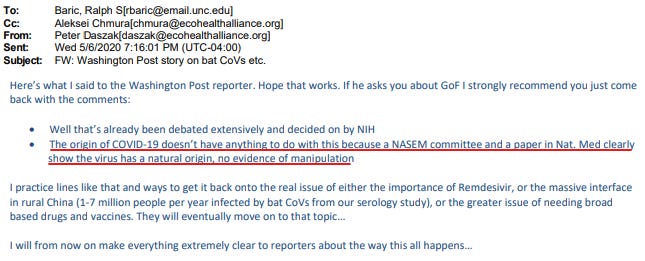










Great encyclopedic synthesis.